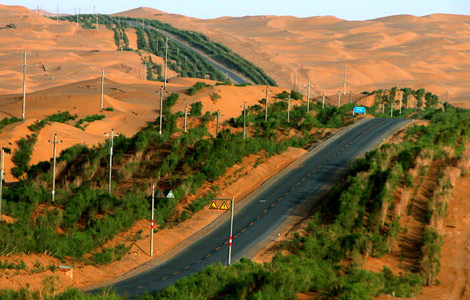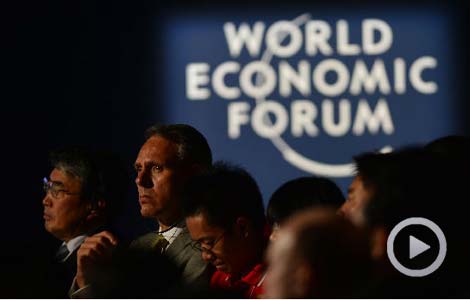Vital partner in green drive
Updated: 2013-09-17 08:19
By Jim Yong Kim (China Daily)
|
||||||||
For the past 30 years, China has pursued its goal of economic development at high speed, growing an average of about 10 percent per year. Roughly 500 million people were lifted out of poverty during this time, and China is now the world's second-largest economy.
These are remarkable achievements for any country, let alone one the size of China. However, the strains of such rapid growth have become increasingly clear, such as environmental degradation and its impact on people's health. The country's leadership is now appropriately reflecting how best to improve the quality of life for Chinese citizens.
To meet these aspirations, one of the greatest challenges in our lifetime for China - and the world - is tackling the effects of climate change. We do not need to look far to find tragic reminders that climate change is a real and present threat which can set back years of development progress.
In July, a deluge of heavy rainfall in Southeast China led to widespread flooding and landslides killing dozens while hundreds are still missing. In August, the Heilong (Amur) River on China's Northeastern border with Russia burst its banks, causing the worst flooding in a century, cutting off roads and isolating entire villages.
Evidence is mounting that such extreme weather events - droughts, floods, storms and wildfires - have all increased over the last several decades, some linked to climate change. A recent World Bank report, "Turn Down the Heat: Climate Extremes, Regional Impacts, and the Case for Resilience", reveals how rising global temperatures increasingly threaten the health and livelihoods of people across regions, with the potential for mega disasters to become commonplace.
Climate change is a top priority for the World Bank and we (at the World Bank) are working with countries, organizations, civil society groups and others across the world to find solutions. China will play a critical part. Its sheer size magnifies the challenge, with rapid growth and urbanization exacerbating the problem.
China is now the largest contributor to global greenhouse gas emissions by volume. Its per capita emission has risen to 7.2 carbon dioxide metric tons, comparable with countries of the European Union.
The good news is the Chinese government is acting to address the challenge on an equally massive scale. It has pledged to reduce its carbon intensity by 40-45 percent by 2020 compared to 2005 levels, and to increase its non-fossil fuel-based energy consumption to 15 percent by 2020.
China now leads the world in small hydropower development and in wind capacity, which has doubled every year since 2005 and reached 61 gigawatts in 2012. Its renewable energy consumption between 1990 and 2010 was as high as all European countries combined.
The World Bank Group is supporting China's efforts to do more. Yesterday, I signed a memorandum of understanding with the chairman of the National Development and Reform Commission to expand cooperation in the areas of climate change, clean energy, reduction of traffic jams and air pollution, and improved flood risk management.
This builds on our historic partnership with China, with more than half of the World Bank's 125 active projects focused on the climate change agenda. The World Bank has contributed $5.3 billion in lending for climate change initiatives in China, leveraging an additional $36 billion from government, private sector and other sources and thereby facilitating a total investment of more than $40 billion. Our private sector arm, the International Finance Corporation, committed a record $347 million to climate-related projects last year alone. That was one-third of IFC's overall $1 billion commitments in China.
For example, we are working together to transform Shanghai into a low carbon city by improving energy efficiency in buildings, as well as promoting green mobility through clean, efficient vehicles and public transport.
Over the last two decades, we have supported China's adoption and large-scale implementation of clean technologies. We are now supporting its pilot trading schemes to achieve green targets more cost effectively. These include carbon cap and trade through the Partnership for Market Readiness initiative, energy efficiency trading, and renewable energy quotas and trading.
As our report shows, the world could warm by 2 C above pre-industrial levels in 20 to 30 years unless dramatic action is taken now, with devastating impacts on agricultural production, water resources, coastal ecosystems and communities.
As an institution that has set a target to end extreme poverty by 2030 and build shared prosperity, we are committed to helping countries reduce greenhouse gas emissions as well as prepare for a world of dramatic climate and weather extremes. While climate change will have an impact on everyone, it is the poor who are most heavily affected and the least able to cope.
The world can learn a lot from China's experience. I am greatly encouraged that China is committed to becoming a bigger part of the global solution. China and the world need such bold action, and the World Bank Group will help in every way possible.
The author is president of the World Bank Group.
(China Daily USA 09/17/2013 page12)

 Thirteen dead in US Navy Yard shooting
Thirteen dead in US Navy Yard shooting
 Exporters to face more trade friction
Exporters to face more trade friction
 Toddler-death defendant says he meant no harm
Toddler-death defendant says he meant no harm
 Watchdog bites with no favor
Watchdog bites with no favor
 Miss New York crowned 2014 Miss America
Miss New York crowned 2014 Miss America
 Summers withdraws from Fed chair contest
Summers withdraws from Fed chair contest
 Scientists make land arable again
Scientists make land arable again
 Stranded cruise guests flown home
Stranded cruise guests flown home
Most Viewed
Editor's Picks

|

|

|

|

|

|
Today's Top News
Trending news across China, Sept 17
BRICS pledge cooperation on climate change
CBRC set to regulate 'chaotic' WMPs
Exporters to face more trade friction
Thirteen dead in US Navy Yard shooting
China, US team up on Central Asia
UN confirms nerve gas used in Syria
Minimum growth rate set at 7 percent
US Weekly

|

|






